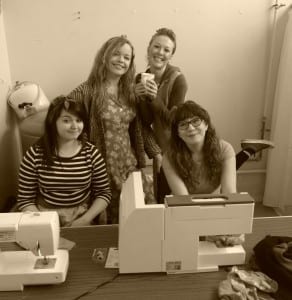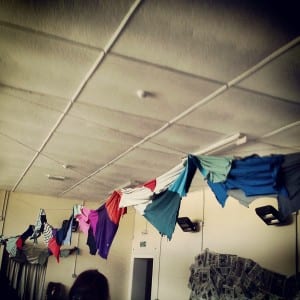The Women at War were transcendent within ‘Safe Bet’ as a whole production. As the audience arrived, they were able to watch four ladies who were dressed in authentic 1940’s attire, performing their morning ritual of getting ready for whatever the day may hold. “Rituals are performative: they are acts done; and performances are ritualized: they are codified, repeatable actions” ((Schechner, Richard (1994) Companion Encyclopedia of Anthropology, ed. Tim Ingold, London and New York: Routledge)) The group thought that by having a couple of rituals signifying the morning rituals of these women, and repeating them, we would be demonstrating Schechner’s thoughts. We decided to use four actions linked with four objects: a comb; a perfume diffuser, powder and brush and some lipstick. The ladies were placed in front of four hooks in the exterior wall of the Grandstand on which, it is believed, the horses used to be tied to. These acted as the mirrors for the ladies but also raised issues of pre-war women, women that would have frequented the racing at the Grandstand, being ‘tied’ to the men of the time by marriage or by social conventions. The audience were able to view this happening for a while and passed it when walking into the Grandstands weighing room, where the majority of ‘Safe Bet’ took place.
Once the audience had taken seats inside, the women journeyed indoors and through to the back of the weighing room, which was concealed by a curtain. Since the piece was centered on three rotational exercises, this was a chance for the audience to be briefed on which rotation they would be partaking in first. Between each rotation the Women of War group came into the briefing room and presented some more rituals that women used to employ regularly. The first of these was to rub tea bags on their legs to stain them the colour of stockings, this was done as stockings were difficult to come across during war time England. Not only was it a way of showing a historical fact, but this linked in with our ‘tea’ theme and was a talking point for the audience. The smell and look of the act was noticed on several occasions. Secondly we explored the drawing on of stocking seams, down the back of our legs in eyeliner pencil, this was also a way to make it look as though they were wearing stockings during the war. This was met with exclamations of “my nan used to do that” and “what are they doing?” from some audience members, showing a mixture of confusion and nostalgia. This gives evidence towards “nostalgic performances are more suasory than other forms of nostalgia because they involve embodiment, enactment and/or performativity.” ((Barry Brummett (ed.) (2009) Sporting Rhetoric: Performance, Games and Politics, New York:Peter Lang Publishing)) Towards the beginning of the process, we thought about filming some of these actions instead of performing them on the day. In retrospect I am pleased with the effect the live performance had on the audience that a pre recorded film may not have had.
Once the audience had been rotated between all of the exercises the Women of War stepped forward and stood in between the two male army officers. By standing next to the men at the front of the audience the group were showing the shift from women lacking power pre-war, to the beginnings of equality with men during the war, with women taking on new roles and exerting power themselves for the first time. Once the audience had returned, the Women of War thanked them for coming to give blood, as a group we had recently found out that the grandstand had been used as a donation station for blood and wanted to include this somehow within our piece. Acting as nurses, the audience were instructed to follow the women into the next room and wait for a nurse within the marked box. This was met with some nervous laughter from a few audience members. Once the audience had been taken to the box, the Women of War left to set up the factory space.
With the sewn cloth hanging above us, pointing to the bathroom which had become a factory, the audience were instructed to begin their next shift. Four or Five audience members were instructed to enter the factory itself and take a seat on the bench. The rest of the audience were stood looking in from the doorway giving the effect of a museum exhibition such as those we saw at the museum of Lincolnshire Life. The structured scene worked well, with Vera Lynn playing to create atmosphere, and the noise of the sewing machines breaking up the femininity of her voice. An audience member told us later that this mixture of sounds, enhanced by the aroma of tea and perfume had made her quite nostalgic and a little sad. The whole piece was a juxtaposition of abandonment and business. A ghostly nod to the way of life that the grandstand had seen, women taking center stage in society and bringing together the community. The tea representing the taking of that community from the grandstand itself.
As it happened, all of the audience members that received the tea were male, this lead to an alternative reading of the taking of the tea. As well as it being the downfall of community, it could also have been interpreted to be the women taking the power (tea) from the men and pouring it down the drain. Until recently, women were not rewarded for their efforts during the war; therefore another reading could have been the women taking the rewards from the men and tipping them away to say ‘we deserve this too’ or something along those lines. The fact that there were many readings to the taking of the tea is very interesting and has been my favourite part of the experience. Learning how gender, age and even personality can affect how you interpret an act or performance to mean completely different things.

